
|
Two New Latent Print
Latent Print Research Publications:
1. Hicklin RA,
Ulery BT,
Ausdemore M,
Buscaglia J. “Why
do latent
fingerprint
examiners differ
in their
conclusions?”
Forensic Science
International 320,
Nov 2020.
After 22
Dec 2020, the
article is
available through
the International
DOI Foundation
(IDF) at
https://doi.org/10.1016/j.forsciint.2020.110542
2. Kalka ND,
Beachler M,
Hicklin RA.
“LQMetric: A
Latent Fingerprint
Quality Metric for
Predicting AFIS
Performance and
Assessing the
Value of Latent
Fingerprints.”
Journal of
Forensic
Identification
70(4) 443-463, Oct
2020.
The above papers
are part of 14 publications in the FBI
Lab/Noblis latent print quality/black
box/white box series of studies:
3. Hicklin RA,
Ulery BT, Busey
TA, Roberts MA,
Buscaglia J. “Gaze
behavior and
cognitive states
during fingerprint
target group
localization.”
Cognitive
Research:
Principles and
Implications, 2019
4:12.
https://doi.org/10.1186/s41235-019-0160-9
4. Ulery BT,
Hicklin RA,
Roberts MA,
Buscaglia J.
“Factors
associated with
latent fingerprint
exclusion
determinations.”
Forensic Science
International,
275:65-75, June
2017.
http://www.fsijournal.org/article/S0379-0738(17)30065-8/
5. Ulery BT,
Hicklin RA,
Roberts MA,
Buscaglia J. “Data
on the
interexaminer
variation of
minutia markup on
latent
fingerprints.”
Data in Brief, 8:
158–190, September
2016.
http://www.ncbi.nlm.nih.gov/pmc/articles/PMC4889892
6. Ulery BT,
Hicklin RA,
Roberts MA,
Buscaglia J.
“Interexaminer
variation of
minutia markup on
latent
fingerprints.”
Forensic Science
International,
264:89-99, July
2016.
http://dx.doi.org/10.1016/j.forsciint.2016.03.014
7. Ulery
BT, Hicklin RA,
Roberts MA,
Buscaglia J.
“Changes in latent
fingerprint
examiners’ markup
between Analysis
and Comparison.”
Forensic Science
International
247(2014):54-61;
Feb 2015.
https://doi.org/10.1016/j.forsciint.2014.11.021
8. Ulery BT,
Hicklin RA,
Roberts MA,
Buscaglia J.
“Measuring what
latent fingerprint
examiners consider
sufficient
information for
individualization
determinations.”
PLoS ONE 9(11):
e110179, Nov 2014.
https://journals.plos.org/plosone/article?id=10.1371/journal.pone.0110179
9. Kalka ND,
Hicklin RA. “On
relative
distortion in
fingerprint
comparison.”
Forensic Science
International
244(2014), 78-84,
Nov 2014.
https://doi.org/10.1016/j.forsciint.2014.08.007
10. Ulery BT,
Hicklin RA,
Kiebuzinski GI,
Roberts MA,
Buscaglia J.
“Understanding the
sufficiency of
information for
latent fingerprint
value
determinations.”
Forensic Science
International
230(1-3):99-106;
July 2013.
https://doi.org/10.1016/j.forsciint.2013.01.012
11. Hicklin RA,
Buscaglia J,
Roberts MA.
“Assessing the
Clarity of
Friction Ridge
Impressions.”
Forensic Science
International
226(1-3):106-17;
March 2013.
https://doi.org/10.1016/j.forsciint.2012.12.015
12. Ulery BT,
Hicklin RA,
Buscaglia J,
Roberts MA.
“Repeatability and
Reproducibility of
Decisions by
Latent Fingerprint
Examiners.” PLoS
ONE 7(3), March
2012.
https://journals.plos.org/plosone/article?id=10.1371/journal.pone.0032800
13. Hicklin RA, et
al; “Latent
Fingerprint
Quality: A Survey
of Examiners”;
Journal of
Forensic
Identification
61(4), July 2011.
14. Ulery BT,
Hicklin RA,
Buscaglia J,
Roberts MA.
“Accuracy and
Reliability of
Forensic Latent
Fingerprint
Decisions.”
Proceedings of the
National Academy
of Sciences
108(19), April
2011.
https://www.pnas.org/content/108/19/7733
A Note for FBI NGI
Users...
One of the most
valuable pieces of
fingerprint-related
information shared
at the 2018 IAI
Conference
involves FBI Lab
and CJIS research
about about NGI
latent print
search result
candidate scores. At the IAI Conference in San
Antonio, FBI Latent Print Examiner Kyle
Tom explained that preliminary research
showed that when the matching scores of the #1
and #2 candidates have a difference of 1,250 or
more, 83.5% of the time it will be an
identification.
This is important
because it means
all agencies
should consider
implementing a
policy that any
such 1,250 or more
difference in NGI
candidate
responses should
require review by
more than one
examiner - either
because the first
examiner made an
identification, or
because there is
an increased
chance of an
erroneous
exclusion.
Hopefully, the FBI
will publish
research on this
topic in the
future.
Some agencies
are of the opinion
that allowing
examiners to see
the matching
scores in
candidate lists
biases them and
should be
precluded. The
current chair of
the OSAC Friction
Ridge Subcommittee
AFIS Best
Practices Task
Group (Mike
French) and I are
both of the
opinion that AFIS
matching scores
are an important
objective measurement which
can lend valuable
information to the
examination
process and assist
quality assurance.
-
Ed German
Certified Latent
Print Examiner,
IAI
Certified
Biometrics
Professional, IEEE
14 Oct 2018
DNA or Latent
Prints? Or Both?
by Raymond A,
Jorz, FFS, Senior
Fingerprint/Firearms
Examiner
and
Karen M.
Zavarella, Ph.D,
Forensic Analyst
Presented at the
CUGI Annual
Educational
Conference - 30
Oct-1 Nov 2017
These slides include
information about
how to
successfully
harvest both
latent print and
DNA evidence from
the same
specimens/surfaces.
The
collection of DNA
from latent print
ridge detail by
peeling open tape
or hinge lifters
in the lab, and
from
cyanoacrylate-developed
ridge detail, and
other evidence
scenarios are
addressed.
The need for
sterile,
single-use brushes
and powders is
addressed, along
with their study
results about how
little DNA
cross-contamination
they found upon
analyzing
brushes/powder
used at multiple
(many) crime
scenes.
Testimony Issues
in a Post-PCAST
World
November 2017 by
Rachelle Babler,
CLPE
Presented at the
CUGI Annual
Educational
Conference - 30
Oct-1 Nov 2017
These slides
address some of
the issues and
concerns for
testifying in
modern times, when
Defense knows
there is a need
for transparency
in reports and
testimony to
comply with
current standards,
guidelines and
best practices.
The slides
also address the
PCAST report error
of not considering
the clerical
errors (as much as
35 of 42 answers)
in the Miami Dade
study; and the
fact PCAST ignored
that 100% of
errors in the
Miami Dade and
FBI/Noblis Black
Box studies were
caught during
subsequent
verification
actions.
Unusual, Genius
and Stupid Tactics
for More
Fingerprint and
Face
Identifications
(2017 Update)
by Ed German, CLPE
Presented at the
CUGI Annual
Educational
Conference - 30
Oct-1 Nov 2017
This
presentation
outines numerous
options to
consider for
identifying more
persons in current
cases, and some
cold cases, by
working smarter
(not harder) to
balance accuracy,
timely support and
thoroughness.
Latent
Print Report
Appendix
October 2017 by Ed
German, CLPE
Attaching an
appendix at the
end of latent
print reports may
help with
transparency in
communicating
limitations,
methods and
overall
information.
Here is a sample
Latent Print
Report Appendix.
This appendix is
used by the Macon
County (Illinois)
Sheriff's Office
(MCSO).
The MCSO appendix
is modeled after
an
FBI Lab Latent
Print Report
appendix, but
with FBI-specific
references
modified to
include SWGFAST,
etc., documents.
The FBI Lab Latent
Print Report
appendix is
excerpted (pages 5
through 7) from
the online
document
here.
A Review of Recently Published Fingerprint
Research (2016-2017)
by Robert Ramotowski, US Secret Service
Presented at the International Association for Identification
102nd Annual Educational Conference - August
2017
Another valuable annual
review of friction ridge research
publications.
Presented at the International Association for Identification
102nd Annual Educational Conference - August
2017
This presentation includes
information about how to struture validation
studies for common processes (e.g., ninhydrin)
as well as novel methods. An example of a
recent study conducted in the presenter's
laboratory is included.
Old vs. New Fingerprint Information Exchange
by Michaela Spankova, Stefania Bohmerova,
Dusan Mikulaj Institute of Forensic Science,
Slovak Republic
Poster presentation at the International Association for Identification
102nd Annual Educational Conference - August
2017
This presentation addresses
the little known
pioneering work of
the Denmark Police
who initiated the
world's first
electronic
encoding of
fingerprint
minutiae
(incorporating
some features of
the modified Henry
classification
system)
facilitating
remote electronic
identification
(confirmation that
minutiae
corresponded) and
exclusion.
Be sure to scroll-down through the multiple
slides.
The NIST (NBS) 1969 technical
note reviewing
Jörgensen's system
is
online here. The 1922 English version of a book describing Jörgensen's
"Distant Identification" system is
online here.
Poster presentation at the International Association for Identification
102nd Annual Educational Conference - August
2017
This presentation addresses
the effects of various temperature and
humidity combinations over time for the
development of latent prints. Ambient
development conditions (not artifically
increased humidity) were shown to be optimal
in this study. The presentation diagram shows
a fuming cabinet with specimens positioned
above the heated cyanoacrylate.
Be sure to scroll-down through the multiple
slides, or
download the PDF file and open on your
computer to see bookmarked sections.
IMPROVING THE RIGOR OF THE LATENT PRINT
EXAMINATION PROCESS
PhD Thesis by
Austin Hicklin
Now publicly
available, this interesting and informative
document details past, current and future
developments, activities and ideas impacting
the quality and thoroughness of latent print
examination work in the demanding environment
of the modern world.
Development of
Latent Fingermarks
from Difficult
Surfaces by Laser
Light Sources by Shiquan Liu, PhD Institute of
Evidence Law and
Forensic Science
China University
of Political
Science and Law Presented at the International Association for Identification 101st Annual Educational Conference - August 2016 This presentation explains
successful laser
development and
visualization
techniques applied
to difficult
surfaces,
including bricks,
stone, wood, train
tickets and cloth.
The presentation
includes
contributions from
Zhongliang Mi,
Weisi Cai, and
Brian Dalrymple.
ENFSI Best
Practice Manual
for Fingerprint
Examination by Maj. Aldo Mattei, PhD RIS
Carabinieri, Italy Presented at the International Association for Identification 101st Annual Educational Conference - August 2016 This presentation addresses
the Best Practice
Manual for
Fingerprint
Examination issued
by the European
Network of
Forensic Science
Institutes
(ENFSI). The
manual considers
fingerprint
examination from
receipt of items
into a laboratory
to the delivery of
a report as a
seamless and
interdependent
process. It does
not consider the
recovery of
fingermarks from
the crime scene,
although much of
the information
within the
visualization
chapter is
relevant. The full
manual is online
here.
The Strength of
Conclusions by Michelle Triplett, CLPE Presented at the International Association for Identification 101st Annual Educational Conference - August 2016 This presentation discusses a
more accurate and
transparent
approach for
arriving at, and
reporting, results.
The full published
paper addressed by
the presentation
is online
here.
A Review of Recently Published Fingerprint Research by Robert Ramotowski, US Secret Service Presented at the International Association for Identification
101st Annual Educational Conference
August 2016 This presentation provides a brief overview of a selection of articles published since mid-2015.
Validation Studies
in ISO 17025
Accredited
Laboratories by Robert Ramotowski, US Secret Service Presented at the International Association for Identification
101st Annual Educational Conference
August 2016 This presentation addresses
key elements of
Level I, II and
III validation
procedures,
including
documentation.
New Paradigm for Fingerprint
Reporting Without Individualization by Henry Swofford, Chief Latent Print Unit US Army Criminal Investigation Laboratory Presented during a Forensic Technology Center of Excellence webinar on 14 July 2016 In November 2015, the Defense Forensic Science Center (DFSC) issued an Information Paper
announcing the decision to cease using the terms “individualization”
and “identification” in latent print technical reports and expert
witness testimony. This presentation explained the reasoning
behind the new reporting language of the DFSC. For over
100 years, fingerprint evidence has been used as a valuable tool for
the criminal justice system. Relying on the generalized premise
of “uniqueness”, the forensic community has regarded fingerprint
evidence as nearly infallible having the capacity to “individualize”
the source of a fingerprint impression to a single individual.
While the uniqueness of a complete record of friction ridge skin detail
is generally undisputed, the extension of that premise to partial and
degraded impressions has become a central issue of debate.
Nevertheless, forensic science laboratories routinely use the terms
“individualization” and “identification” in technical reports and
expert witness testimony to express an association of a partial
impression to a specific known source. Over the
last several years, there has been growing criticism among the
scientific and legal communities regarding the use of such terms to
express source associations which rely on expert interpretation.
The crux of the criticism is that these terms imply absolute certainty
and infallibility to the fact-finder which has not been demonstrated by
available scientific data. As a result, several authoritative
scientific organizations have recommended forensic science laboratories
not to report or testify, directly or by implication, to a source
attribution to the exclusion of all others in the world or to assert
100% infallibility and state conclusions in absolute terms when dealing
with population issues. Consequently, the traditional paradigm of
reporting latent fingerprint conclusions with an implication of
absolute certainty to a single source has been challenged. The
underlying basis for the challenge pertains to the logic applied during
the interpretation of the evidence and the framework by which that
evidence is articulated. By recognizing the subtle, yet
non-trivial differences in the logic, the fingerprint community may
consider an alternative framework to report fingerprint evidence to
ensure the certainties are not over or understated.
Out of the Frye-ing pan and into the Fire by Francis P. Senese Presented
at the Illinois Division, International Association for
Identification's (IAI) 54th International Educational Conference -
April 2016 This presentation details historical background and
other important factors to consider for Dauberrt, Frye and similar
scientific process challenge hearings.
Transmogrification
- Surgical incisions and rotation of fingerprint focal point areas
(e.g., cores, delta) before suturing.
Automated Face & FP Criminal Justice Resources by Ed German Presented
at the Illinois Division, International Association for
Identification's (IAI) 54th International Educational Conference -
April 2016 This presentation details face and fingerprint
repositories US law enforcement can leverage today to solve more
crime... (even if they have no in-house face experts).
NIST Seeking Fingerprint Examiners for Facial Identification Study Dear Colleague, One of
the key questions
in forensics is
measuring the
accuracy of facial
forensic
examiners. To
address this
question, we are
conducting
the Measuring the
accuracy of facial
forensics
comparisons research
study. This
research study
will measure the
performance of
facial forensic
examiners using
the tools and
methods in their
laboratory. We are
recruiting facial
forensic examiners
to compare the
faces in 20
image-pairs and
answer a
background
survey.
We are also
recruiting
non-examiner face
experts and
fingerprint
examiners to take
the same study.
Non-examiner face
experts are
familiar with
faces but have not
been trained in
facial forensic
comparisons. We
are looking for
fingerprint
examiners who do
not have
experience in
facial
comparisons.
Fingerprint
examiners have
been trained
forensic
comparison but do
not have
experience with
faces. These two
groups will allow
for a detailed
analysis of the
accuracy of facial
forensics
comparisons.
By participating
in this research
study, you will
assist in
developing a
scientific measure
of performance of
facial forensic
comparison. These
results may help
meet the Daubert
standard for the
admissibility of
expert witness
testimony.
By volunteering
for this research
study, you may
request your
accuracy at
comparing the
extremely
challenging faces
in this study. If
you are willing to
volunteer, please
contact the
principle
investigator, Dr.
Jonathon Phillips,
by email at jonathon.phillips@nist.gov or
by phone at +1
301-975-5348.
FBI's Biometric Center of Excellence by Nick Megna, Unit Chief, Biometric Center of Excellence, FBI CJIS, Clarksburg, West Virginia Presented
at the International Association for Identification's (IAI) 100th
International Educational Conference - August 2015 This
presentation details current activities and future plans involving the
FBI's biometric projects including fingerprint, face, iris and voice
modalities.
A Review of Recently Published Fingerprint Research by Robert Ramotowski Presented
at the International Association for Identification (IAI) 100th
International Educational Conference - August 2015 This
presentation provides a partial overview of articles appearing in
non-IAI publications during 2014-2015.
A Possible Model
for R&D –
Maintaining the
“Scientist" in the
Forensic Scientist by Eliot Springer,
Deputy Director
NYPD Police
Laboratory, New
York City, NY This presentation
addresses
obstacles and
novel solutions to
increase research
and development in
the modern
forensic science
laboratory
environment.
Improving Morale,
Opening Lines of
Communication, and
Keeping the
Criminalist
Engaged by Eliot Springer,
Deputy Director
NYPD Police
Laboratory, New
York City, NY This presentation
explains how
implementing a
variety of
outside-the-box
ordinary, unusual,
and fun activities
can improve the
flow of
communications,
reduce stress,
improve
productivity and
provide other
benefits.
IT Project in Poland Supporting LP Development on Difficult Porous and Non-Porous Surfaces
by the Central Forensic Laboratory in Warsaw and the Police Academy in
Szczytno, Poland Poster presentation at the
International Association for Identification's (IAI) 99th International
Educational Conference - August 2014
This poster from S. Zubanski, A. Tyzwa, T. Szcepanski, K. Klemczak and
U. Wieckiewicz outlines the planned development of software cataloguing
and documenting validated processes for latent print development on
difficult surfaces. Additionally, IT development will include
creation of a comprehensive electronic infrastructure supporting
forensic units with modern software solutions for real world
conditions. The project is supported by The National Centre for
Research and Development.
Fingermark Visualisation Manual by Helen Bandey, PhD
Presented at the International Association
for Identification's (IAI) 99th
International Educational Conference -
August 2014
The presentation explained and demonstrated the automated,
interactive fingerprint visualization
manual. (These slides are not
interactive, but include screen shots of
sample pages from various sections.)
This
manual replaces the widely
used "Manual of Fingerprint Development
Techniques." It has been vastly revised and
extended and it is presented in a new style
to reflect advances in both science and
operational practice.
The
new manual has been implemented across all UK
police forces. Others may purchase the
electronic manual from
tso-shop.co.uk.
Administrative Decisions within the
Universal Latent Workstation Software
by Patricia Mason, Training Instructor, FBI
CJIS
Presented at the International
Association for Identification's
(IAI)
99th International Educational
Conference - August 2014
This presentation explains new features of
the FBI's newest (soon to be released) ULW
software. New capabilities include
civil database searches, a direct email
interface (still being developed), Next
Generation Identification (NGI) interface
capabilities, and much more.
Understanding Digital Image Processing
by Allison Loll, PhD, CLPE
Presented at the International
Association for Identification's
(IAI)
99th International Educational
Conference - August 2014
This presentation (A Look Behind the
Scenes: Understanding Digital Imaging
Processing) addresses important aspects of
digital imaging, including accurate and
complete answers for image
processing-related questions in court.
Conducting Forensic Science Research
Projects
by Robert Ramotowski
Presented at the International
Association for Identification's
(IAI)
99th International Educational Conference
- August 2014
Topics addressed
include effective planning, research,
design, conduct, documentation and
publication of forensic science research.
Latent
Print Research Projects
by
Robert Ramotowski
Presented at the International
Association for Identification
(IAI)
99th International Educational
Conference - August 2014
This presentation covers a variety of
US Secret Service research, including the following
- Developing
Latent Prints on Coated Papers
- Developing
Latent Prints on Stone Papers
- Impact of Latent
Print Reagents on Ink Analysis
- Processing Business
Envelopes with Polystyrene Windows
- Effect of
Acidifying Ninhydrin on Latent Print
Development
A Review of Recently Published Fingerprint
Research
by Robert Ramotowski
Presented at the International
Association for Identification
(IAI)
99th International Educational
Conference - August 2014
It is difficult for most latent print
examiners to keep up with articles published
in so many different journals. This
presentation provides a brief overview of a
selection of articles published since 2013.
Evolution of Latent Print Development Techniques
by Robert Ramotowski
Presented at the IAI's 98th International Educational Conference - August 2013
Latent Print Development and Identification Survey
by Robert Ramotowski and Didier Meuwly, PhD
Presented at the IAI's 98th International Educational Conference - August 2013
Fingerprint Source Book
This UK source book was discussed by Rory Downham during his above presentation about the Home Office's new Fingerprint Visualisation Manual at the IAI's 98th International Educational Conference - August 2013
An Evaluation of a Novel One-step
Fluorescent Superglue Process
by Robert Ramotowski
Presented at the International Association for Identification's
97th International Educational Conference on 26 July 2012
The Use of
Anti-Stokes
Upconversion
Powders and
Infrared Laser
for
Fingerprint
Visualization
by
Marisa Bender
and Robert
Ramotowski
Presented at
the
International
Association
for
Identification's
97th
International
Educational
Conference on
26 July 2012
Nonconformities,
Corrective
Actions and
Root Cause
Analysis
for Latent
Print
Decisions
by
Frank
Fitzpatrick
Presented at
the
International
Association
for
Identification's
97th
International
Educational
Conference on
26 July 2012
Click
here for a
black and
white version
of the above
slides.
Small, Large and
Very Large
AFIS
Operations
Things
to consider
when you
specify a new
system or
upgrade...
by
Behnam
Bavarian
Presented at
the
International
Association
for
Identification's
97th
International
Educational
Conference on
26 July 2012
Understanding
Basic
Statistical
Concepts
(as Applied to
Fingerprints)
Presented by
Michele
Triplett, CLPE
at the
International
Association
for
Identification's
97th
International
Educational
Conference on
24 July 2012
Latent Print Exam Study Questions
Courtesy of
Henry
Templeman of
the San Jose
Police Department
Right-click
and download
the above PDF
file to review
on your
computer.
(PDF
File help tips
are here.)
These study
questions are
neither IAI
LPCB approved
nor endorsed -
but may help
give examiners
an idea of
their
knowledge
level in
preparation
for the LPCB
Exam.
These
questions were
prepared in
2006 and thus
do NOT include
materials from
more recent
reference
materials.
Be sure to
study all the
cited
reference
materials to
acquire
knowledge
sufficient to
pass.
The Philosophy of Friction Ridge Examination ...see an interesting
presentation
by Boyd
Baumgartner
(via
vimeo).
Here is a link to other
vimeo
presentations
he has
created.
You can also
take Boyd's
practice Ten
Print
Certification
test at www.fs2d2.com
Tips,
Tricks and
Best Kept
Secrets
(Universal Latent Workstation and NGI)
presented 11 August 2011 by Jeff Carlyle at the 96th
Annual IAI Educational
Conference.
Latent Print
Development
Techniques for
Thermal Paper presented 10 August 2011 by Aldo Mattei and Federico
Cervelli at
the 96th
Annual IAI
Conference.
Chicken or
the Egg:
Process for
Latent Prints
or DNA First? presented 9 August 2011 by Diana Tabor and Karley Hujet
at the 96th
Annual IAI
Conference.
Community of
Fingerprint Experts
in Columbia
Get the Latest Version of Universal Latent Print Workstation (ULW 6.0 plus)... Even if You Do Not
Currently
Submit Latent
Print Searches
Directly to
the FBI, You
Can Use ULW
Extended
Feature Set
Capabilities
to Help with
Casework
Documentation
of Level 1, 2
and 3
Information.
ULW now
includes
improved
casework
management
tools.
SWGFAST Glossary and other Documents
NIST
Latent
Fingerprint Home
Page
NAS Report: Strengthening
Forensic
Science in the
United States:
A Path Forward
Access
the 41-page Free
Executive
Summary here.
Report
Description
from the National Academies Press:
"Scores
of talented
and dedicated
people serve
the forensic
science
community,
performing
vitally
important
work. However,
they are often
constrained by
lack of
adequate
resources,
sound
policies, and
national
support. It is
clear that
change and
advancements,
both
systematic and
scientific,
are needed in
a number of
forensic
science
disciplines to
ensure the
reliability of
work,
establish
enforceable
standards, and
promote best
practices with
consistent
application. Strengthening
Forensic
Science in the
United States:
A Path Forward
provides a
detailed plan
for addressing
these needs
and suggests
the creation
of a new
government
entity, the
National
Institute of
Forensic
Science, to
establish and
enforce
standards
within the
forensic
science
community.
The benefits
of improving
and regulating
the forensic
science
disciplines
are clear:
assisting law
enforcement
officials,
enhancing
homeland
security, and
reducing the
risk of
wrongful
conviction and
exoneration. Strengthening
Forensic
Science in the
United States
gives a full
account of
what is needed
to advance the
forensic
science
disciplines,
including
upgrading of
systems and
organizational
structures,
better
training,
widespread
adoption of
uniform and
enforceable
best
practices, and
mandatory
certification
and
accreditation
programs."
News Release on the report.
Access
the report here:
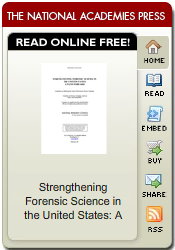
Webcast of the 18 Feb 2009 NAS briefing.
New
forensic term
after 18 Feb
2009
(?):
Nif·ty
[ níftee ]
adjective
(comparative
nif·ti·er,
superlative
nif·ti·est)
Definition:
1.
compliant with
National
Institute of
Forensic
Science requirements.
2.
stylish and
good-looking:
fashionable
and
good-looking
3.
agile: good,
quick, and
clever at
doing
something or
using
something
4.
very good:
very good or
effective
Click
here to see news articles on this topic.
Identifying the Needs of the Forensic Sciences Community
Interesting
documents online
at the
National
Academies of
Science
Committee on
Science,
Technology and
Law
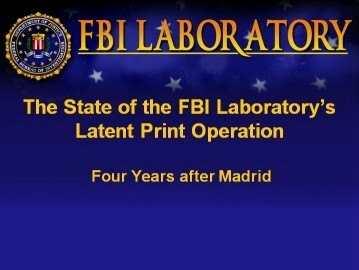
Presented
by the FBI
Laboratory at
the IAI
Conference on
18 August 2008
Right-click
and download
before opening
these large
files:
PDF
Slides
(2.4 Mb)
PowerPoint
Slides
(3.1 Mb)
See
new Standards
and Draft
Standards from
SWGFAST
Position Paper on Latent Fingerprint Identification from
the IAI...
29
Nov 2007, from
the International Association for Identification.
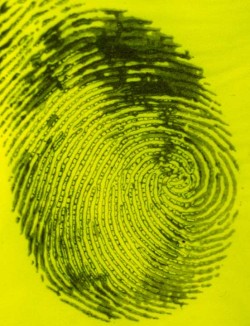
ACID YELLOW Development of
Bloody Latent
Prints on Dark
Surfaces...
27 Jul 2007
IAI
presentation,
courtesy
of
the
US Army Criminal
Investigation
Laboratory.
Right-click
here to
download the
large
PowerPoint
version of
this
presentation,
then open on
your computer.
Right-click here to download the large PDF version
of this
presentation,
then open on
your computer.
Ninhydrin
Development
without
expensive or
dangerous
solvents.
Research from Korea...
Major Case Prints DRAFT Card
A new card for
recording all
finger
joints/tips
and thenar
(base of palm)
areas was
drafted by
SWGFAST in
September
05.
It is
anticipated
that the new
Major Case
Prints form
number will be
FD-884A.
The new card is intended to
facilitate
comprehensive
record finger
and palm
prints (AKA
Major Case
Prints) when
fully
completed with
existing FBI
Fingerprint
Card (Form
FD-249 front
and back
) and
FBI Palmprint
Card (Form
FD-884 front
and back
)
records.
The below
draft design
has not been
approved by
the FBI and
may undergo
modifications
during vetting
with the IAI
and other
internal and
external
interested
parties.
See the
CLPEX.com
discussion
about MCPs and the new card
here.
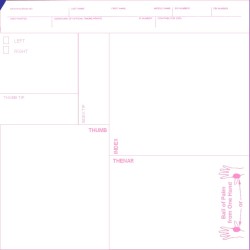 Blank Card Front
Blank Card Front
 Blank Card Back
Blank Card Back
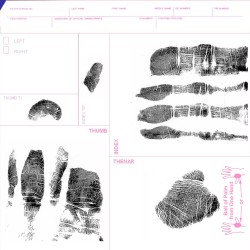 Sample Card Front with Prints
Sample Card Front with Prints
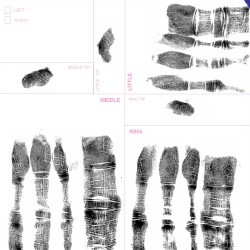 Sample Card Back with Prints
Sample Card Back with Prints
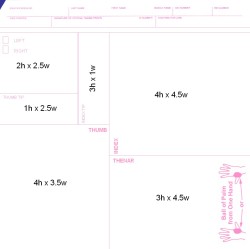 Card Front Block Sizes
Card Front Block Sizes
 Card Back Block Sizes
Card Back Block Sizes
MCP
standardization
will assist
AFIS as more
vendors design
systems for
handling all
friction ridge
areas of the
hands.
Interesting
transcript from a BBC February 2006 Newsnight
interview with
Dr. Itiel Dror
on the topic
of contextual
bias and
experts.
Madrid Error
Prints,
including
Algerian
Ouhnane
Daoud's record
print, are
online here .
The
US Department
of Justice's
March 2006
documents
related to the
Madrid Error
are online at
http://www.usdoj.gov/oig/special/s0601/PDF_list.htm
(Recommend
downloading
these files
before opening
from your
computer).
Among
other
findings, the
330 page
report
criticizes the
FBI
Laboratory's
Examination
SOP, and
SWGFAST
guidelines, as
repetitive,
vague and
general.
The five-page
conclusion
from the
report is
available here (much
smaller file)
.
|
" The Myth of Goats : How many people have
fingerprints
that are hard
to match?"
by Austin
Hicklin, Craig
Watson and
Brad Ulery
Published as a
NIST
Interagency
Report, NISTIR 7271
|
|
|
7 Sep 2005 Massachusetts Supreme Court Oral Arguments (swf file type)
about Admissibility of Simultaneous
Impressions
RE:
Commonwealth
v. Patterson
|
|
| New Hampshire June 2005 Daubert Challenge |
|
| Another Simon Cole Article about Fingerprint Error Rates ...Cole
begins by
hinting that
fingerprint
testimony is
similar to
selling fake
insurance
policies
(right-click to save and open this 94
page pdf
document)
|
New
Books on AFIS
and Biometrics
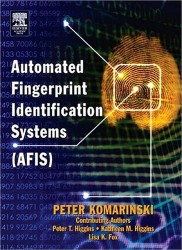
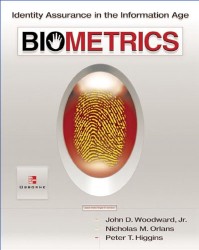
|
|
|
|
|
Stephen Meagher's
August 2002
IAI Conference Daubert
Presentation
(hint...
right click the Daubert
Presentation link and save
to your computer for best
results)
|
|
The CLPE
Roster has been updated.
|
| " Do Fingerprints Lie?
" another article
ignoring the existence of standards
and certification
in the fingerprint discipline.
Michael Specter's 27 May 2002 piece
in The New Yorker. |
| Online article about the alleged ease in
spoofing biometric fingerprint
readers (Gummi Bears?). Related
commentary appears here.
In
considering the concept of
spoofing biometric systems, don't
forget that biometric
fingerprint reader systems do
not identify fingers, but
instead determine whether the
ridge detail pressed on the
reader is similar enough to the
registered fingerprint data to
trigger a green light instead of
a red light using matching
criteria AS SET FOR THAT SYSTEM.
- Ed German
|
RUVIS-related
commercial links:
e-symposium
spex
crimescope
jobinyvon
|
What
is a Daubert Hearing and how do you
pronounce it?
| A Statement
Regarding Am eri can News Shows and
Articles about Fingerprint Evidence
Credibility in Court...

|
|
Judge Pollak
Reverses Himself
The
Honorable Louis H. Pollak wrote:
Based on the
foregoing considerations, I have
concluded that arrangements which,
subject to careful trial court
oversight, are felt to be
sufficiently reliable in England,
ought likewise to be found
sufficiently reliable in the federal
courts of the United States, subject
to similar measures of trial court
oversight. In short, I have changed
my mind. "Wisdom too often never
comes, and so" - as Justice
Frankfurter admonished himself and
every judge - "one ought not to
reject it merely because it comes
late." (7
January 2002 Court Decision
partially against fingerprints
Court Decision
)
PA v. Vikara,
Convicted After Starrs' Testimony
Prof. James Starrs was
called as an expert in the methodology
of fingerprint comparison, but
renounced much of his written report
during cross-examination.
Hearing was October 22, 2001...
Defendant convicted of 1st Degree
Murder and Robbery... sentenced to
death. Defendant died January 10, 2002
in the State Correctional Institute at
Camp Hill, PA.
A Judge Takes a
Close look at Simon Cole
A New York state judge
listened to testimony by Simon Cole
about why he considers the science of
fingerprint identification suspect...
and ruled, ..."Even applying the
Federal Court's Daubert Standard, what
Dr. Cole has offered here is 'junk
science"...
( Court Decision )
( Cole's Testimony
)
One of Bin
Laden's Terrorists Tried a
Daubert Challenge to FP's
- After
his April 6, 2001 conviction, Ahmed
Ressam was known to most of us as
just another criminal who failed in
his bid to exclude incriminating
fingerprint evidence. As Paul Harvey
would say, we now know the rest of
the story...
Discussion Forum
at OnIn
Read what your peers are
asking and answering...
ANSI/NIST:
Click HERE
to read
ANSI/NIST-ITL 1-2000. It covers the
" Data Format for the
Interchange of Fingerprint,
Facial, & Scar, Mark &
Tattoo (SMT) Information
" and is the revision of ANSI/NIST-
CSL 1-1993 & ANSI/NIST- ITL
1a-1997.
And
YES , it does cite the
new 1000 ppi higher resolution
friction ridge file types... and the
1K, 2K, etc., migration path for
higher resolution. Congratulations to
Mike McCabe, the IAI, SWGFAST and
other organizations and individuals
responsible for helping craft
improved national standards!
Equipment and
Supplies
Find your goodies online...
FBI Forensic
Science Communications
Forensic Science
Communications is a forensic science
journal published quarterly in by FBI
Laboratory personnel. It is a means of
communication between forensic
scientists.
FBI LP Processing
Guide
Right-click
the above link to download the Year
2000 FBI Latent Print
Processing Guide. This
document is 344
KB and will work best if you
download it to your computer
(especially if you are using a
telephone modem).
 Many thanks to Tim
Trozzi, Rebecca Schwartz, and Mitch
Hollars of the FBI
Lab for updating the manual,
and to the FBI
for making
the Year 2000 version public.
Many thanks to Tim
Trozzi, Rebecca Schwartz, and Mitch
Hollars of the FBI
Lab for updating the manual,
and to the FBI
for making
the Year 2000 version public.
Fingerpint
Consultants
Experts with an online
presence...
INS
Fingerprinting $$$
Anticipated to cost up
to $500 million, Senate Bill 1491
introduced on 3 OCT 01 will hopefully
sail thru Congress quickly in this
time of need for fingerprint screening
in America.
INTERPOL AFIS
Expert Group
The IAEG is currently
composed of representatives from eight
member countries: Brazil, Canada,
France, Germany, Norway, Spain, United
Kingdom, and the United States,
representatives from Interpol and an
observer from Europol. It is the
charter of the IAEG to develop and
propose for adoption...
Help Wanted...
LP Examiner Jobs
Looking for a change?
Ready to retire and start
anew?...
The Future of
the LP Discipline
Slides from the
July 2001 IAI
Conference
Level 1, 2 and 3
Detail
Level 1 includes the
general ridge flow and pattern
configuration. Level 1 detail is
not sufficient for individualization,
but can be used for exclusion.
Level 1 detail may include information
enabling orientation, core and delta
location, and distinction of finger
versus palm. Level 2...
Prints on Skin
Because the same
chemicals naturally deposited in
latent prints are also present on the
rest of the body's skin, successful
latent print detection on skin
normally involves a contaminant of
some type (blood, dirt, lipstick, wet
paint, vaseline, etc.). I
recommend detectives look carefully at
the victim's skin for any obvious
"finger or palm ridge detail" (not
just red marks on the skin).
Success may come in the form of
...
Problem Idents
There is zero tolerance
for friction ridge identification
error in forensic science.
Ignoring standards causes
errors. A minimum number of
Galton detail "points" does NOT equal
an identification standard. The
standard for identification is not a
number. As demonstrated below...
Ruthenium Tetroxide
Used
more in Japan than the US, here's
another tool to be aware of...
LP Examination
Safety - OSHA Report
In February 1992, the
National Institute for Occupational
Safety and Health (NIOSH) received a
request for a health hazard evaluation
(HHE) from a management representative
of the Federal Bureau of Investigation
(FBI) in Washington, D.C. The request
was submitted because of concern
about...
 Those interested in
furthering their knowledge will want to
read David Ashbaugh's new
book . Visit your
library, borrow a friend's or buy
one.
Those interested in
furthering their knowledge will want to
read David Ashbaugh's new
book . Visit your
library, borrow a friend's or buy
one.
Sample
Expert Testimony (decades old,
but still interresting)
(Testimony
about Lee Harvey Oswald) My full name is
Sebastian Francis Latona. I am the
supervisor of the latent fingerprint
section of the identification division
of the Federal Bureau of Investigation.
I attended Columbia University School of
Law, where I received degrees of LL.B.
LL.M., M.P.L. I have been with the
Federal Bureau of Investigation for a
little more than 32 years. I started in
the identification division as a student
fingerprint classifier, and since that
time I have worked...
SCAFO
This non-profit
organization was founded in 1937 with
forty charter members dedicated to the
profession of fingerprint
identification. This Southern
California based association is
comprised of more than 300 members
from over 50 different law enforcement
agencies...
Shirley
McKie.com
Website devoted to the victim of the
Scottish Criminal Record Office's
fingerprint identification error.
Super Glue
Fuming
Cyanoacrylate
(Superglue) Fuming Tips - Lessons
Learned - Caution notes - Safety
Background Information - Discovery
Timeline...
SWGFAST - Peer
Reviewed National Standards
In 1995, the United
States Federal Bureau of
Investigation, hosted a group of
latent print examiners at the FBI
academy to discuss developing
consensus standards which would
preserve and improve the quality of
service provided by the latent print
community....
Upcoming
Training
Read about upcoming
training opportunities or post new
information for the rest of
us...
|
|
|
 |




